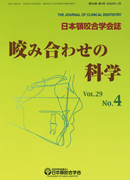Volume 29, Issue 4
Displaying 1-12 of 12 articles from this issue
- |<
- <
- 1
- >
- >|
-
2009Volume 29Issue 4 Pages 236-241
Published: November 24, 2009
Released on J-STAGE: February 03, 2015
Download PDF (764K) -
2009Volume 29Issue 4 Pages 242-251
Published: November 24, 2009
Released on J-STAGE: February 03, 2015
Download PDF (1199K) -
2009Volume 29Issue 4 Pages 252-265
Published: November 24, 2009
Released on J-STAGE: February 03, 2015
Download PDF (858K) -
2009Volume 29Issue 4 Pages 266-275
Published: November 24, 2009
Released on J-STAGE: February 03, 2015
Download PDF (5144K) -
2009Volume 29Issue 4 Pages 276-289
Published: November 24, 2009
Released on J-STAGE: February 03, 2015
Download PDF (2279K) -
2009Volume 29Issue 4 Pages 290-297
Published: November 24, 2009
Released on J-STAGE: February 03, 2015
Download PDF (672K) -
2009Volume 29Issue 4 Pages 298-307
Published: November 24, 2009
Released on J-STAGE: February 03, 2015
Download PDF (1213K) -
2009Volume 29Issue 4 Pages 308-313
Published: November 24, 2009
Released on J-STAGE: February 03, 2015
Download PDF (1887K)
-
2009Volume 29Issue 4 Pages 314-319
Published: November 24, 2009
Released on J-STAGE: February 03, 2015
Download PDF (2586K)
-
2009Volume 29Issue 4 Pages 320-325
Published: November 24, 2009
Released on J-STAGE: February 03, 2015
Download PDF (1224K) -
2009Volume 29Issue 4 Pages 326-330
Published: November 24, 2009
Released on J-STAGE: February 03, 2015
Download PDF (2682K) -
2009Volume 29Issue 4 Pages 331-335
Published: November 24, 2009
Released on J-STAGE: February 03, 2015
Download PDF (1218K)
- |<
- <
- 1
- >
- >|
